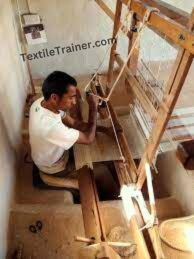Dynamic History of Loom: From Handloom to Power Loom
What is Loom?
A loom is a device that used to weave cloth and tapestry. In this article, we will brief a dynamic history of loom. The basic purpose of any loom is to hold the warp yarn or ends under tension in order to facilitate the interweaving of the weft yarns. Although the precise shape and mechanics of the loom vary, the basic purpose remains the same.
A loom is derived from the Old English word “geloma” derived from the prefix ge- (perfective prefix) and the root loma, which meant a tool or machine of any kind, whether it is a utensil, a tool, or a machine. It was used to mean a machine for weaving thread into cloth in 1404. By 1838, it meant a machine for interlacing threads.

History of Loom
The first looms didn’t start to evolve dramatically until the Middle Ages, machines like this one were used. This invention was likely Chinese, since the treadles raised several different heddles, which allowed for complex patterns. In Turkey and Palestine, the first known fabrics were found at the end of the Neolithic period. The draw loom is a model which is allows the weaving of patterns using treadles or some other mechanism. The heddles are raised and lowered to open the shed in the warp threads. Claude Dangon, a French weaver, simplified its use at the beginning of the 18th Century by attaching these different combinations to numerous runners that another person would lift in turn.
In the past, a shuttle was used to push the weft thread through the warp: the shuttle enclosed the weft thread, which limited the width of the fabric. Weavers had to pass the shuttle from one weaver to another to make large pieces on looms.
John Kay, a British weaver, invented the Flying Shuttle in 1733. It revolutionized weaving by allowing the shuttle to fly from one end to the other. Flying shuttles were omnipresent for more than two centuries, until mechanical looms were invented.
Automation of looms, such as the Jacquard loom invented in 1801, was a major technological and social revolution in the 19th Century. Jacquard looms are also referred to as “bistanclaques” by the French (because of the noise they make)
In this machine, the name of the inventory is Joseph Marie Jacquard from Lyon, which controls the loom with punched cards with rows corresponding to each design row. There are multiple rows of holes punched into each card, and each card is strung together in order to create the textile design. With this invention, it is easy to manufacture textiles with complex patterns like brocade, damask, and quilted.
In 1892, Shigejiro Matsuda perfected the foot operated loom in which there are two pedals were pushed alternately to continuously perform the three weaving operations and received a patent for it. In 1896, Sakichi Toyoda invented the first Japanese power loom, the Toyoda Steam power loom.

In West Asia, weaving probably began much later than spinning, around 6000 BC. The first people used fingers to weave narrow bands, then tied one end to their belts. It was akin to finger-knitting. It wasn’t until later that looms were invented that people began to use them. However, these are the history of loom. I tried to present history of loom simple way.
Reference:
- banerjee, N. (2000). Weaving Mechanism. West Bengal: Smt. Tandra Banerjee and Sri Apurba Banerjee.
- Belal, P. D. (2016). Understanding Textiles for a Merchandiser. Dhaka: LB Graphics & Printing.
- Corbman, B. P. (1987). Textile Fiber to Fabric. Singapore: McGraw Hill Book Co.
- Gandhi, K. (2012). Woven Textiles. New Delhi: Wood Publication Limited.
- Gokarneshan, D. N. (2009). Weaving Preparation Technology. Delhi: Abhishek Publicaions.
- Rahman, M. M. (2008). Fabric Manufacturing Technology. Dhaka: Books Fair Publications.
- V. Gordeev, P. V. (1982). Cotton Weaving. Russia: Mir Publishers Moscow.



